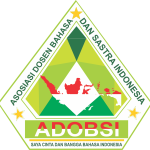Tiga Novel Karya Okky Madasari: Perspektif Kriminologi Lingkungan
Abstract
Human survival depends heavily on environmental sustainability. If the ecosystem is disturbed, the welfare of human life will also be disturbed. Nature is a bridge for writers and writers of literary works to convey the atmosphere, image, setting, or major themes that exist in literary works. Three novels by Okky Madasari are one of the children's novels in which there are events about the environment that are interesting to study. The importance of this research is to find out the environmental crimes that exist in the three novels. This type of research is a qualitative research. The data collection technique in this research is in the form of library technique. From the research results, three environmental problems are found in the three novels by Okky Madasari, namely poaching, hunting for rare animals and exploitation of the ocean. In the novel, the author not only shows various environmental crime phenomena, but is accompanied by the resolution of every environmental problem, whether it is carried out by the main character or not. Through these novels, it also appears that literary works also have a role in environmental conservation efforts.
Keywords
Full Text:
PDFReferences
Ahmadi, A. (2019). Cak Nun dan esai sastrawinya dalam perspektif kriminologi. Bahasa dan Seni: Jurnal Bahasa, Sastra, Seni, dan Pengajarannya, 47(1), 10-21.
Ahmadi, A. (2019). Metode penelitian sastra perspektif monodisipliner dan interdisipliner. Gresik: Graniti.
Brisman, A., & South, N. (2013). A green-cultural criminology: An exploratory outline. Crime, Media, Culture, 9(2), 115-135. DOI: https://doi.org/10.1177/1741659012467026
Creswell, J. W. (2018). Keterampilan esensial untuk peneliti kualitatif. Yogyakarta: Pustaka Pelajar.
Dermawan, M. K. (2006). Kejahatan lingkungan: Suatu tinjauan kriminologis. Jurnal Masyarakat dan Budaya, 8(2), 97-120. DOI: https://doi.org/10.14203/jmb.v8i2.190
Dewi, N. (2016). Ekokritik dalam Sastra Indonesia: Kajian sastra yang memihak. Adabiyyāt: Jurnal Bahasa dan Sastra, 15(1), 19-37. DOI: https://doi.org/10.14421/ajbs.2016.15102
Eman, K., Meško, G., & Fields, C. B. (2009). Crimes against the environment: Green criminology and research challenges in Slovenia. Journal of Criminal Justice and Security, 11(4), 574-592.
Garrard, G. E. (2012). Ecocriticism. London: Routledge.
Hasan, I. (2008). Analisis data penelitian dengan statistik. Jakarta: Bumi Aksara.
Khaerah, D. (2018). Ekokritik sastra pada novel rahasia pelangi karya Riawani Elyta dan Sabrina WS. Skripsi tidak diterbitkan. Universitas Muhammadiyah Makassar.
Lampkin, J. (2021). Uniting green criminology and earth jurisprudence. New York: Routledge.
Lynch, M. J. (2020). Green criminology and environmental crime: Criminology that matters in the age of global ecological collapse. Journal of White Collar and Corporate Crime, 1(1), 50-61. DOI: https://doi.org/10.1177/2631309X19876930
Madasari, O. (2018). Mata dan rahasia pulau gapi. Jakarta: Gramedia Pustaka Utama.
Madasari, O. (2019). Mata dan manusia laut. Jakarta: Gramedia Pustaka Utama.
Madasari, O. (2019). Mata di tanah melus. Jakarta: Gramedia Pustaka Utama.
Potter, G. (2010). What is green criminology. Sociology Review, 20(2), 8-12.
Ratna, N. K. (2006). Teori, metode, dan teknik penelitian sastra: Dari strukturalisme hingga postrukturalisme perspektif wacana naratif. Yogyakarta: Pustaka Pelajar.
Rifai, A., & Andrian, S. N. (2017). Komunikasi sosial dalam sastra hijau sebagai kontribusi kampanye lingkungan pada pendidikan dasar. PIBSI XXXIX, Semarang 7-8 November 2017.
Rini, W. P. (2018). Paradoks Narasi Penyelamatan Keseimbangan Ekosistem dalam Novel Kailasa Karya Jusuf AN Kajian Ekokritik. Poetika: Jurnal Ilmu Sastra, 6(2), 122-132. DOI: https://doi.org/10.22146/poetika.v6i2.40298
Risnawati, R. (2019). Fenomena kerusakan alam dalam novel luka perempuan asap karya Nafi’ah Al Ma’rab berdasarkan pendekatan ekokritik Greg Garrard. Disertasi tidak diterbitkan. Universitas Negeri Makassar.
Ruggiero, V., & South, N. (2013). Green criminology and crimes of the economy: Theory, research and praxis. Critical Criminology, 21(3), 359-373. DOI: https://doi.org/10.1007/s10612-013-9191-6
Satria, H.D. (2014). Green criminology. Yogyakarta: Indie Book Corner.
Spapens, T. (2016). Invisible victims: the Problem of policing environmental crime. In Environmental Crime and its Victims (pp. 239-254). Routledge.
Sudikan, S.Y. (2017). Ekologi sastra. Lamongan: Ilalang.
Thomson, R., Samuels-Jones, T., & Downs, L. (2019). The branches of green criminology: A bibliometric citation analysis 2000–2017. In Quantitative Studies in Green and Conservation Criminology (pp. 20-46). Routledge.
Thomson, R., Samuels-Jones, T., & Downs, L. (2019). The branches of green criminology: A bibliometric citation analysis 2000–2017. In Quantitative Studies in Green and Conservation Criminology (pp. 20-46). Routledge.
White, R. (2008). Crimes against nature: Environmental criminology and ecological justice. London: Willan.
Widodo, W. (2015). Kriminologi dan hukum pidana. Semarang: Universitas Negeri Semarang Press.Refbacks
- There are currently no refbacks.






